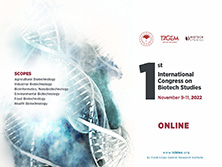GENETIC GAINS IN YIELD OF BREAD WHEAT (Triticıım aestivum L.) CULTIVARS UNDER CENTRAL ANATOLIAN CONDITIONS
2 Zır. Müh.. Tarla Bitkileri Merkez Araştırma Enstitüsü Müdürlüğü. Ankara - Field experiments containing 13 bread wheat cultivars and one advanced line developed in the period of 1933-1991 were carried out under Central Anatolian conditions in order to investigate genetic gains in yields and yield components contributing to yield. According to the average yields, the lowest and the highest yielding varieties were Sivas-111/33 and Gerek-79, respectively. The relationship between yield and years from release of the oldest variety used in the experiment was expressed by an equation of Y 212.98 + 1.61Xr= 0.758**. The genetic gain was found to be 1.61 kg/da.
In the analysis of the results, first of all, correlation coefficients between yield and yield components were measured. In addition, correlation coefficients were partitioned into direct and indirect effects through path analysis. According to the results, the component which was the most effective on yield was number of kernels per spike. Direct effect of kernes spike on yield was found to be positive and high (1.0936). However, indirect effect of kernels` spike via spike m2 was -0.559 and as a result total correlation decreased (r- 0.5366). Direct effect of harvest index on kernels` spike was positive and high (0.7966). Effect of the biological yield on kernels spike was intermediate (0.247). In order to increase the wheat yield under Central Anatolian conditions kernels spike and harvest index should be increased without lowering biological yield. To do that, plant height should be decreased.
Keywords : Bread wheat; Triticıım aestivum L.; yield; genetic gains















